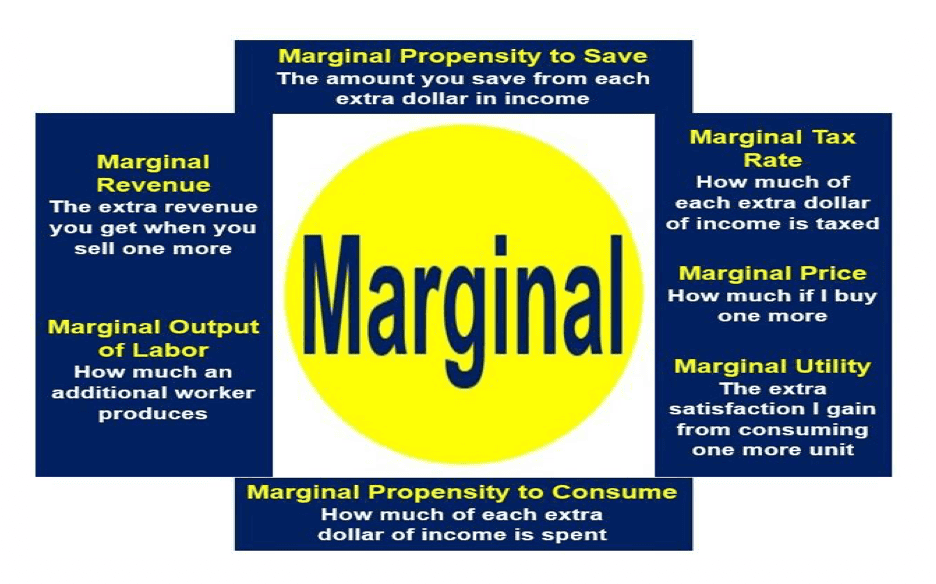What is marginal? Definition and meaning
Marginal, when used in economics, has a similar meaning to ‘additional’. Whenever a business, finance or economics text includes the term, it is usually referring to something that will be added to what was originally there.
The term can also mean ‘not the main part’, as in: a company’s ‘marginal products’, buildings, activities, etc. do not form the main part of its business.
In lay English, marginal has several meanings: 1. Relating to or at the edge. 2. Not important or minor (slight). 3. (of a distinction or decision) very narrow, borderline. 4. A politician’s constituency where the vote in the last election was won with a very slim majority.
 It is all about adding one more onto the pile and measuring the extra pleasure, cost, tax, revenue, price, amount saved, amount spent, amount produced, etc.
It is all about adding one more onto the pile and measuring the extra pleasure, cost, tax, revenue, price, amount saved, amount spent, amount produced, etc.
This article focuses on the term’s meaning in economics. The word may also refer to producing and marketing goods ‘at margin’
According to Dictionary.com, marginal by definition is:
“1. Selling goods at a price that just equals the additional cost of producing the last unit supplied. 2. Relating to goods produced and marketed at margin.”
Different terms using ‘marginal’
Marginal refers to the difference made when an additional unit of something is produced.
– Marginal Revenue: refers to the extra revenue you receive when you sell one more unit of something.
– Marginal Price: is how much extra a buyer has to pay to purchase an additional unit of something. Imagine you buy thirty pencils, and then ask the seller for one more – it is the price of that last, extra one.
– Marginal Utility: the extra utility you get from consuming an additional unit of something. The extra satisfaction you gain from consuming one more unit of a product or service. Economists use this concept to determine how much of a product consumers will buy. It is used to measure pleasure or happiness, and how that affects our decision-making.
Diamonds cost more than water because of the greater satisfaction we get from them. Water has greater total utility (satisfaction we get from consuming a given total quantity of a good or service) while diamonds have greater marginal utility (satisfaction we get from purchasing one more).
– Marginal Output of Labor: this measures how much additional output a company would get if it hired one more worker. If my 100 workers produce 1000 units per week, what would the extra worker produce if I had 101 employees? It also measures how much output would increase by if an employee did an extra hour’s work.
– Marginal **Propensity to Consume: measures how much consumption would increase for every dollar that was added to a person’s income. When we are paid more, most of us do not spend all that extra income – some of it is saved.
** Propensity is a common term used in economics, and may refer to how much of our income we save, spend, use for purchasing imports, etc.
– Marginal Propensity to Save: measures how much of each additional dollar in income goes into savings. Very few of us save one-hundred percent of any extra money we receive. Maybe you would spend 80% of your extra income and save 20% of it.
– Marginal Tax Rate: the amount of additional tax you have to pay for every dollar in extra income that you receive. In other words, the percentage taken from a taxpayer’s next dollar of income above a specified threshold. In most countries, the rate will increase as an individual’s income rises.
Marginal vs. average
To find the average of anything, you simply divide the total by the number of units. If John consumes 2,600 calories per day, Mary consumes 1,900, and Harry burns 3,000, their average daily calorie requirement is:
(2,600 + 1,900 + 3000) ÷ 3 = 2,500
In microeconomics, a common finding is that even tiny incremental changes can matter considerably.
Most successful business people tend to think ‘at the margin’ rather than in marginals. Thinking ‘at the margin’ generally leads to more successful and effective economic decision-making than focusing on the averages.
Video – Marginal revenue and costs
This Saylor Academy video explains the meanings of marginal revenue and costs. The speaker uses the example of a lady who owns an apple orchard. At the end of the video, you are asked to consider whether the government should intervene.

